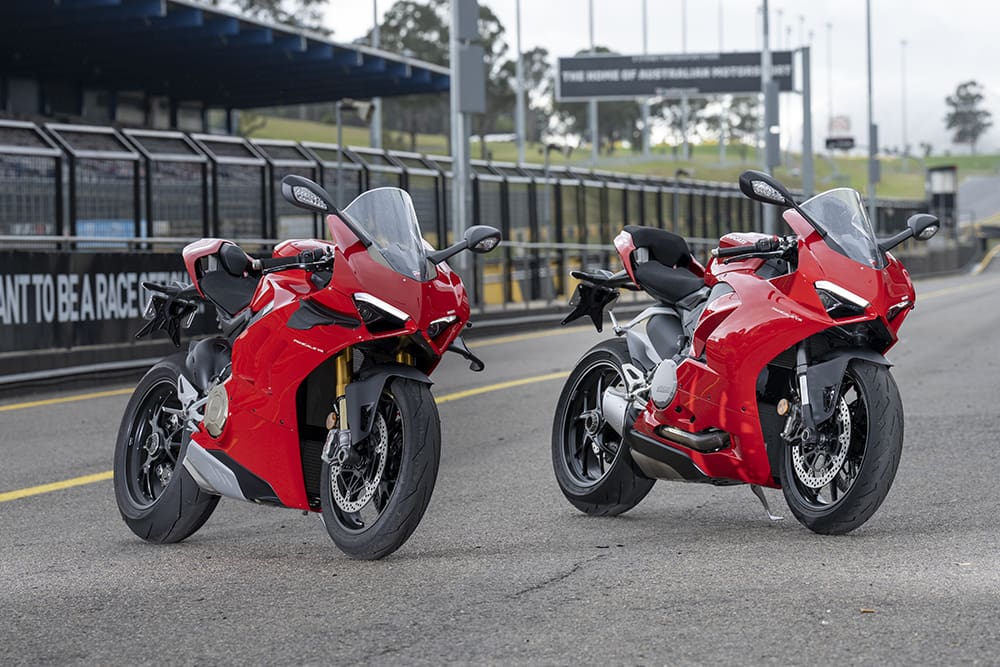The Panigale V2 stays true to the Ducati V-twin tradition. It is over $17k less expensive than the V4 S and just as good looking. So why bother with the four banger?
TEST: PETE VORST PHOTOGRAPHY INCITE IMAGES
When it comes to engine configurations, some brands are very fluid. Look at the big four Japanese brands, for instance, who have powered their bikes with everything from singles to V-fives, and rotaries to inline-sixes. Then there are marques that have become synonymous with one particular configuration; Moto Guzzi, Harley-Davidson and, of course, Ducati who has crafted an image around its L-twin engines. Often customers loyal to these brands resist change, you’ve only got to recall the reaction when Harley-Davidson opted to water cool a few bikes in its range. And you could guarantee if Harley tried to stop making V-twins and started making triples or rotaries, mobs of HOGs would riot.
Ducati’s transition from its long-serving V-twin range to its modern-day V-four preference has been well-received and the Italian marque has managed to avoid the vitriol that even its new sans-Trellis frame Monster is getting pummelled with.
Ducati die-hards don’t seem to have a problem giving the marque a spray for straying too far from tradition so how has the firm managed to dodge a bullet when it strayed off the traditional V-twin line and introduced the V4?
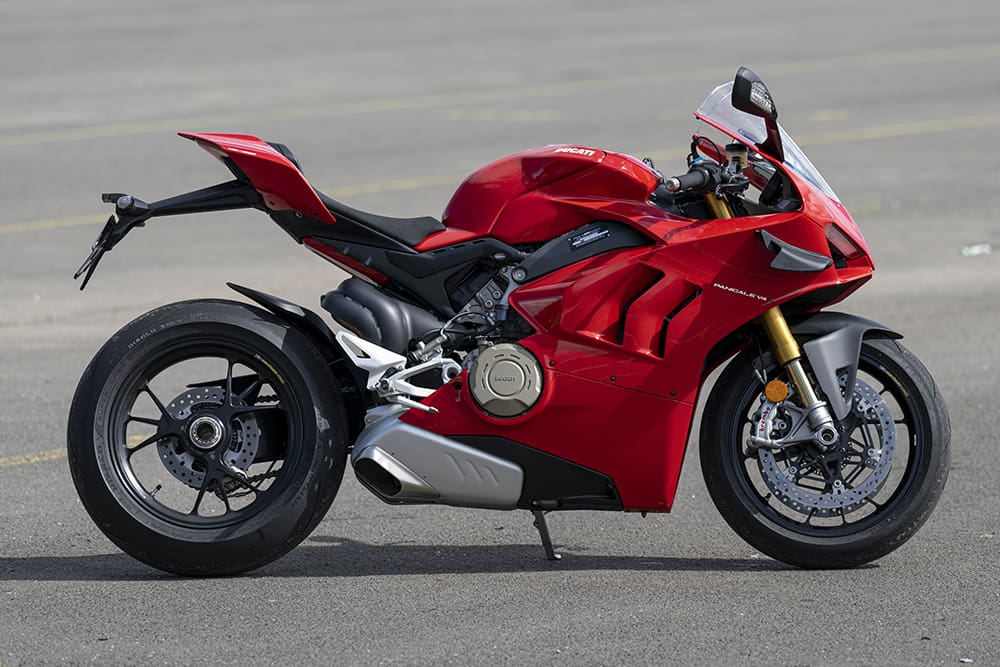
Did the V4 find instant acceptance because of its racing pedigree? (Let’s face it, it did). Is the Panigale V4 just too damn pretty to utter harsh words about? Or could it be that the V4 is just so much better than the V2 that no one bothered kicking up a stink?
Ducati’s marketing department will certainly have you believe that the V4 is that much better than the V2, but both you and I have been around long enough to know that sometimes manufacturer’s claims are just spin.
In this case, however, there’s little in the way of unwarranted spin in the V4 S’s marketing gaff – the V2 is a very trick superbike, but the V4 obliterates it in almost every way.
Let’s get this bit out of the way first. Even if you have a noggin’ that’s cosmetically challenged, people are going to find you more attractive on a shiny, red Panigale regardless of how many pots it’s slamming pistons up and down in. Both bikes look stunning, but the V2 arguably looks more stylish and better finished with its right-side exhaust cut away, more intricate side panels and no carbon wings. Sure, the wings look all MotoGP and stuff, but there’s a hint of afterthought about them, much like Kawasaki’s first-series ZX-12R ram-air duct did compared to the later model’s integrated version.
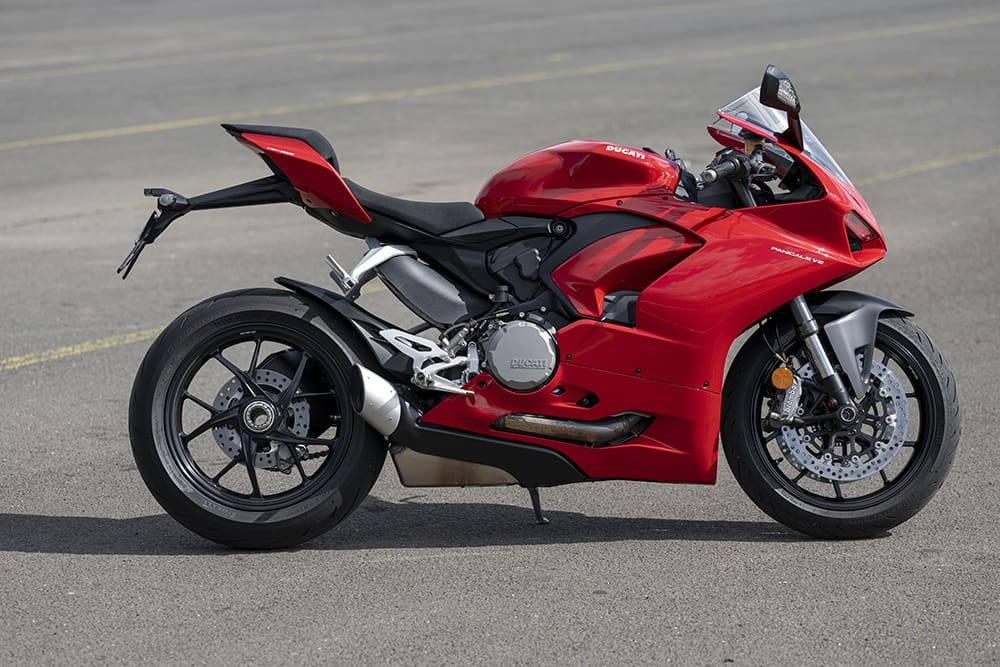
The aluminium-monocoque framed V2 is outgunned in the engine department by its big brother, but the twin cylinder 955cc twin still boasts power and torque figures that would be mighty impressive in alternative company. Producing 115kW (155hp) for the horsepower people at 10,750rpm and 104Nm of torque at 9000rpm, the V2 is no slouch, and the tried-and-tested Superquadro engine has plenty of grunt down low, steps up the pace in the mid-range before really coming on strong up top.
It is an engine that feels well sorted and refined without losing the character of a Ducati twin, it’s also not as insanely intimidating as the V4 so you might be more inclined to push your own riding boundaries.
In the other corner and wearing the red trunks with gold adornments is the V4 S, which is powered by a 1103cc Desmosedici Stradale 90-degree V4 with the four-pot engine cranking out 157.5kW (214hp) at 13,000rpm and 124Nm of torque at just 1000rpm higher than the V2. The V4’s monstrous power is restricted in the first three gears and, combined with the extra wind protection afforded by its fairing and taller screen, it can make the two Italians feel similar at lower velocities, but it’s deceptive.

The V4’s power isn’t retarded in a way that leaves you wanting more, but it’s dialled down just enough to make the thing usable and less tiring to play on. If you find an open enough piece of road where you can let the revs build in fourth, the V4’s ability to gather speed is nothing short of hair raising. It’s a monster, and you’ll never – or at least should never – use its huge potential on the road. And you’ll need to be at a racetrack to see anywhere nearing the V4’s maximum power capabilities.
Both run a six-speed box with two-way quickshifters and those shifters are works of art. So smooth, no matter whether you’re ferociously banging through the gears caressing redline or plugging through a carpark. Both run a wet clutch, but the V2’s smooth and progressive clutch action is miles ahead of the V4’s, which is neither of those. There’s more progression in a set of pliers – and for 40 grand you expect creamy smooth, not grabby and agricultural, which it errs on.
Apart from the engine configuration, the biggest difference – visually at least – is the suspension. The V2 runs a fully adjustable 43mm Showa fork on the front, while Sachs provides a fully adjustable monoshock at the rear. The V4, however, runs salivation worthy Öhlins electronically adjustable units front and rear with different modes providing different setups all the while the ECU is making adjustments on the fly according to road conditions and speed.
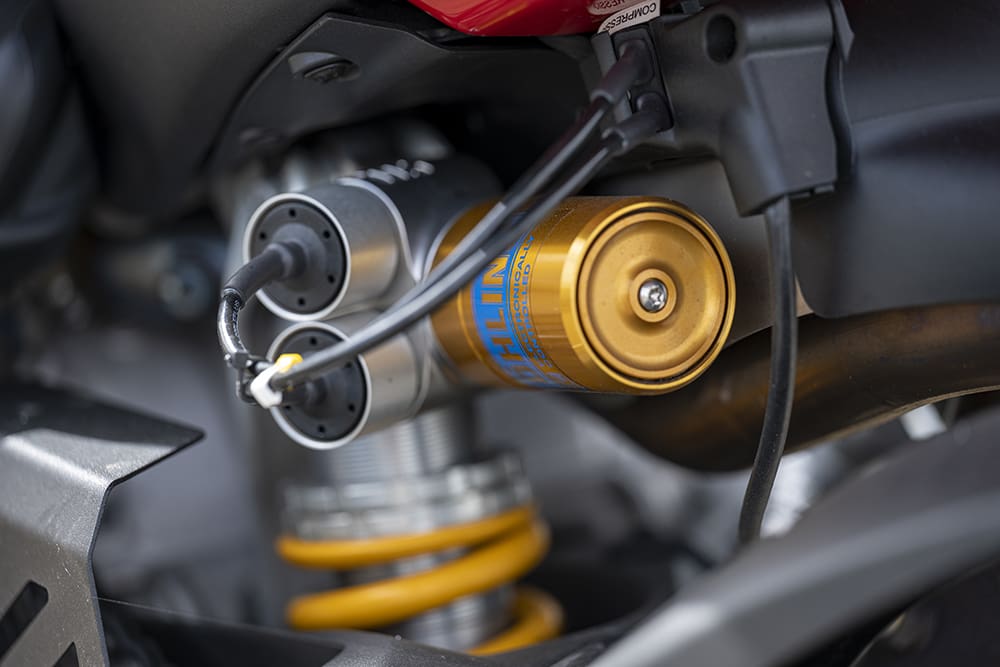
In reality both these bike will do their best work on a racetrack. The V2 is quite firmly sprung and isn’t the nicest thing to ride on rough Aussie roads, but the V4’s ability to soften itself off in road mode makes it a far nicer ride on crappy road surfaces.
The V2 tips the scales at a claimed kerb weight of 200kg with 17 litres of fuel splashing around in it, while the V4 weighs in at a claimed 195kg with its full 16-litre tank.
Both bikes wear Brembo brakes front and rear but, like the engines, the front brakes are a massive point of difference. The 200kg ringing wet V2 wears a pair of radial mounted Brembo Monobloc M4.32 calipers binding to a set of 320mm discs. Meanwhile, the 195kg V4 sports a pair of Brembo Monobloc Stylema M4.30 calipers gripping a set of 330mm rotors. Not a lot of difference on paper, but out in the field the difference is as noticeable as a bastard rock in a shoe. The V2 feels positively wooden compared to the V4 – that’s not to say you should judge the V2’s picks harshly, against any other bike in the AMCN fleet, which included KTM’s 890 Duke R and Indian FTR 1200 S the V2’s brakes are fantastic – it’s just a case of the V4’s brakes being exceptional in every way.
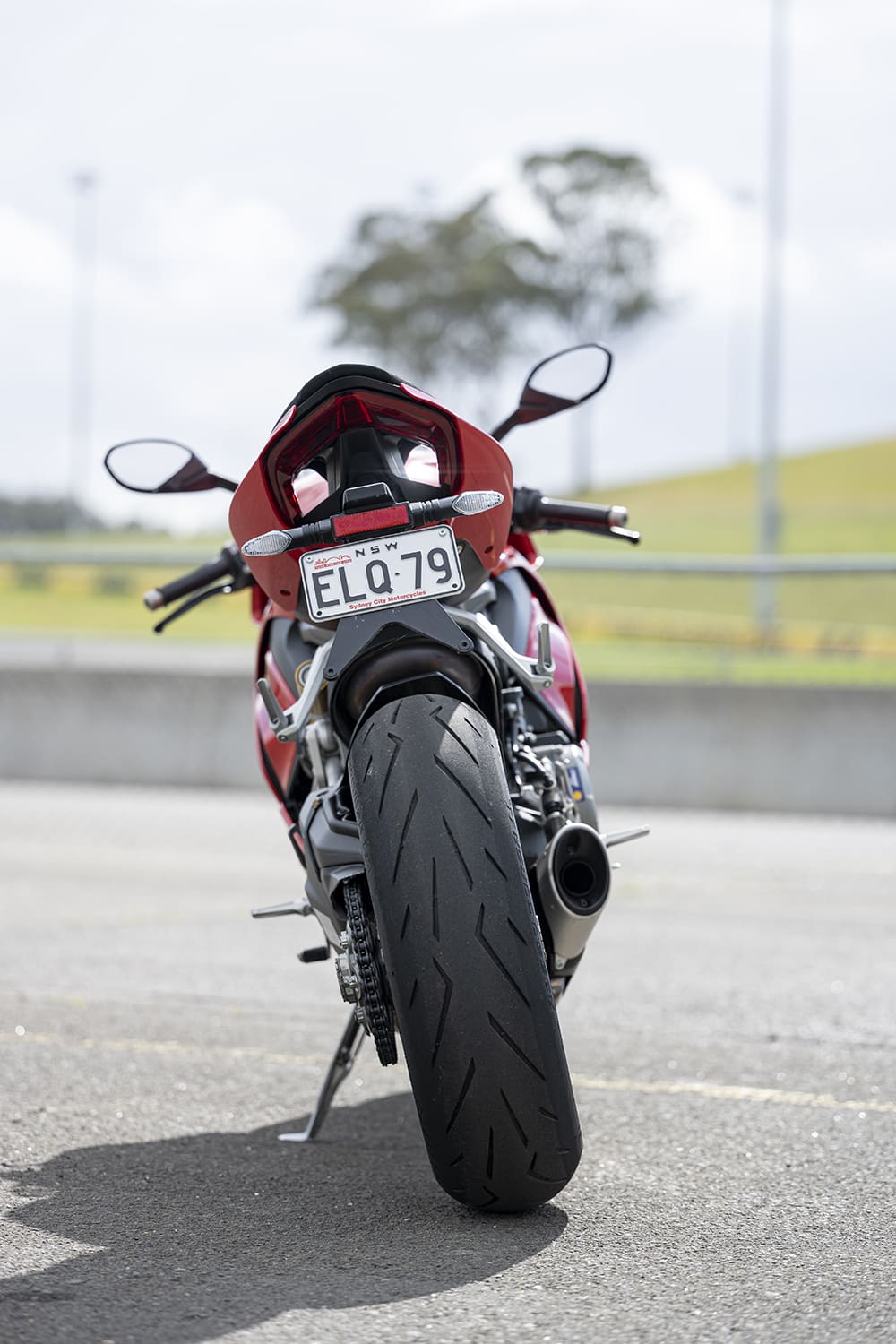
And all that mechanical sexiness is kept inline with one of the most advanced electronics packages on the field. A six-axis IMU fiddles the dials on the cornering-ABS and traction-control systems, wheelie control, engine-brake control as well as slide control, launch control and electronic Öhlins suspension and steering damper. The V2’s system is a tad more basic without the need to control the suspension, but the menu/switch interface is more intuitive and easier to use than the V4’s.
The 4.3-inch TFT dash are similar on both, are easy to read and provide most of the info you need except a fuel gauge. I know these are track-focused weapons, but surely we can get a fuel gauge, even if you had to flip screens to get it. But all you get is a low-level lamp that comes on when the fun is almost over.
I watched a documentary once that said without the aid of its on-board computer systems, a jet fighter would lose control and spear itself into the ground such is the machine’s raw agility and ability. And the V4 S is a little like that in that it is so immensely powerful, and so willing to execute a cornering manoeuvre at warp speed, that without its remarkable suite of high-tech rider aids, if you’re not some ace Superbike pilot you’d probably drill yourself into the tarmac in quick order. The improvements for 2020 mean it’s not the chaotic lunatic of past but it’s still a Wiley character (see the launch report in Vol 69 No 16).

But punching through a set of road corners on the V4 is about as much fun as you can have with your clothes on. There are more composed and stable-feeling bikes on the planet but the V4 is exciting. You can happily and confidently lean on its traction control out of a corner and it’ll draw pretty black lines with composure. But when you’re enjoying play time and the V4 plies more confidence out of you, you just know that if things go bad , they’re really going to properly go bad because you just always seem compelled to go fast on the V4.
The V2 feels a little more planted and just as confidence inspiring, while on the edge of the tyre it feels more composed and is just not as mad-crazy. There’s more time to get yourself composed and think about your cornering strategy. However at road speeds, the differences between the pairs’ handling is splitting hairs. Swapping from bike to bike required just a change of braking marker to counter the V4’s extra pace.
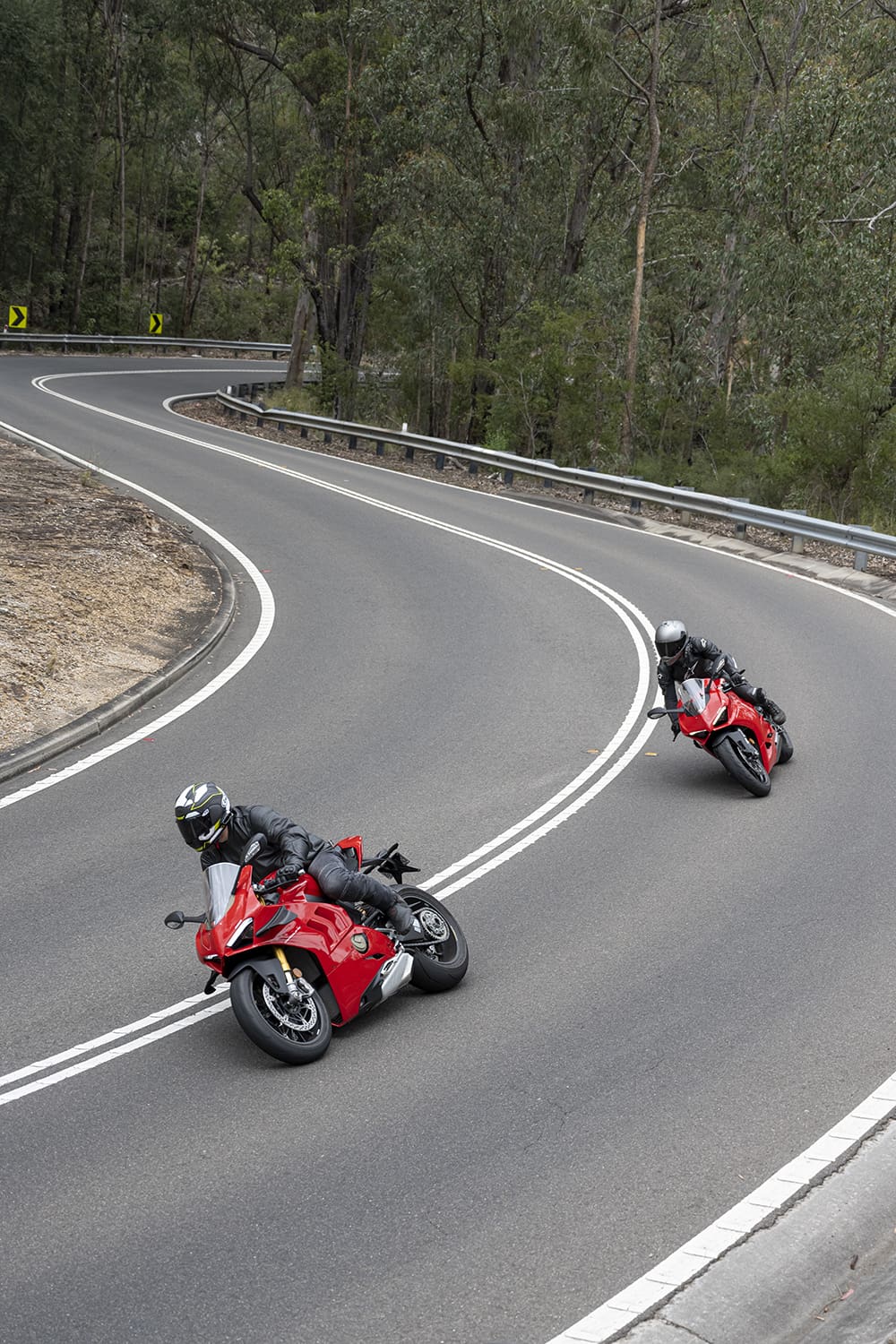
But when it comes to comfort and ergos, the V4 wins hands down, it’s pretty comfortable. A full day of riding gives the old wrists a pummelling but, as open-class sportsbikes go, it’s pretty sweet. There’s plenty of leg room even for my large frame, a nice seat and the screen and fairing offer reasonable wind protection.
But then all that hard work to make the V4 one of the first Ducati superbikes I’ve ridden that I can and want to stay on for more than half an hour without vouchers to a chiropractor’s convention, comes crashing down around your crotch. The two rear cylinders sit right underneath you and absolutely bake your lower internals. I’m not talking ‘a bit uncomfortable at times’, I’m talking ‘you need to ride with your legs splayed to stop your genitals bursting into flames’. Add your left thigh in particular laying against the rear cylinder and it becomes a very unpleasant experience, one that also starts distracting you from the job of threading a 214-horsepower missile through your chosen section of road. As for the V2, well, let’s just say Ducati’s Superbike thermodynamics team chucked a sickie on the day they should have been sorting the cod-burning properties of these two out. The V2 is better, much better, but it’s still unpleasant on a warm day.
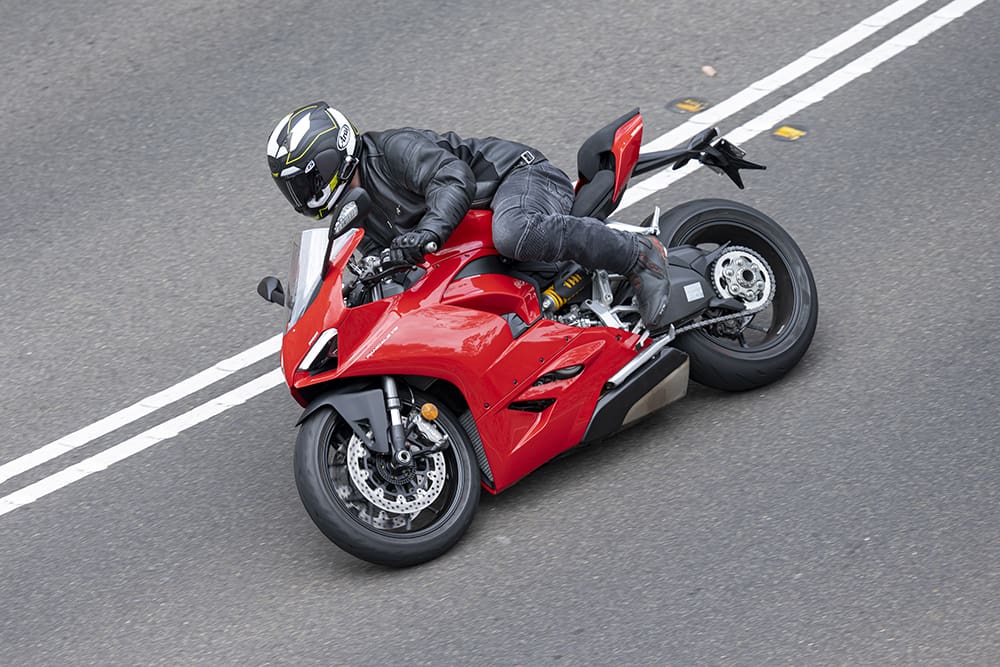
Comfort-wise, the V2 is a brute. We weren’t speaking to one another after just a half hour in the firm seat. There’s maximum weight on the wrists and it pumps a lot of impact through your shoulders. It feels like a
hard-edged racebike with lights fitted.
Apart from the small matter of the $17,490 price difference, a nicer clutch and it not trying to incinerate your intestines to the same degree, I have no idea why you would buy the V2 over the V4. It’s not as fast or exciting to ride, doesn’t stop as well, or have sexy gold Öhlins hanging off it and it’s about as comfortable as a budget airline flight to Melbourne. Not that long ago a 200-plus horsepower superbike was the happy place of superbike racers or deranged adrenaline freaks. But the electronics on the V4 have gone a long way to making it easy to get on with and have fun on even for a mere mortal. But is the V4 over 17 thousand clams better than the V2? Yes. Yes, it is!
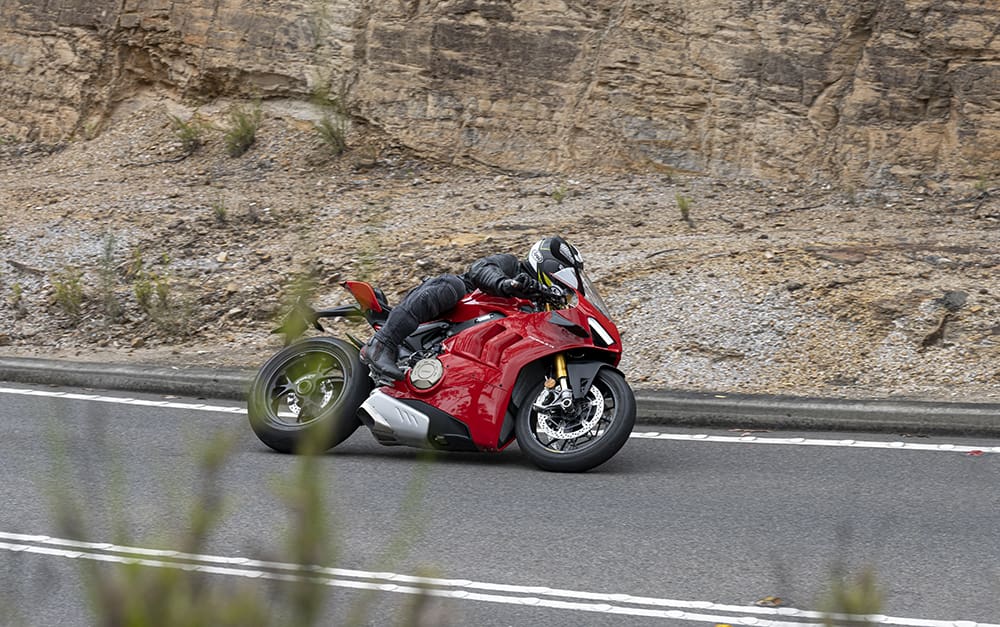
But the reality is neither is a particularly good roadbike. Not unless you only travel short distances and you have a fantasy of being locked up for brutally disobeying the road rules. Both belong on a racetrack and perhaps that’s why the V4 has been accepted so readily into the Ducati clan, because the people who love superbikes love the latest and greatest and care less about tradition. And that V4 S is certainly the latest and greatest Ducati.
